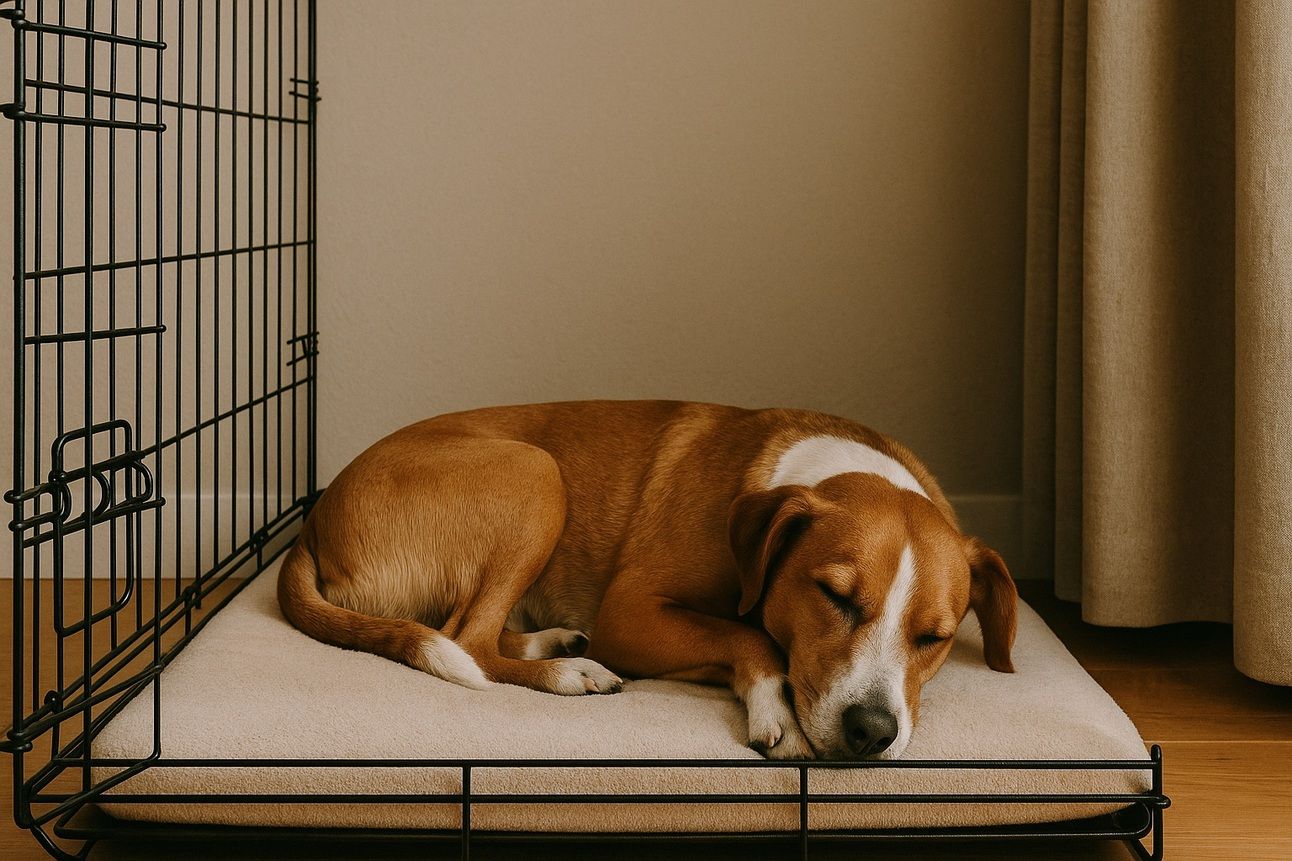- Beorn’s Bark Bus News
- Posts
- Crate Controversy: Is Crating Your Dog Humane or Harmful?
Crate Controversy: Is Crating Your Dog Humane or Harmful?

Few topics in the dog world divide people quite like crating. For some dog parents, crates are lifesavers — a safe space for their pet, a training tool, and a household sanity-saver. For others, the image of a dog in a crate feels too much like punishment or even neglect.
So what’s the truth? Is crating your dog humane or harmful? As with most dog-related debates, the answer depends on how, why, and when you’re using the crate.
Let’s unpack the nuance.
What Is Crate Training?
Crate training is the process of teaching a dog to enter, rest, and feel safe in a crate — typically a plastic, wire, or fabric enclosure with enough space for them to stand up, turn around, and lie down comfortably.
Used properly, a crate mimics a natural “den,” offering a quiet, enclosed space dogs can retreat to when they want to relax. It’s also commonly used for:
Housebreaking (dogs are less likely to eliminate where they sleep)
Preventing destructive behavior when unsupervised
Safely transporting dogs in vehicles
Giving overstimulated dogs a break
The Case For Crating
Many veterinarians, trainers, and behaviorists support crate use — when done correctly. Here’s why:
1. It Can Provide Comfort and Structure
Dogs are den animals by nature. A properly introduced crate can become a go-to place for naps, downtime, and safety. You might find your dog choosing to hang out in their crate even with the door wide open.
2. It Aids in House Training
Crates can be a powerful housebreaking tool, especially with puppies. Because dogs instinctively avoid soiling their sleeping area, they learn to “hold it” until they’re taken outside.
3. It Keeps Dogs (and Homes) Safe
When you’re not home to supervise, a crate can prevent dangerous chewing, ingestion of toxic items, or household destruction — particularly in young or anxious dogs still learning boundaries.
4. It’s a Lifelong Skill
Dogs who are crate-trained are less stressed in situations where confinement is necessary: vet visits, travel, grooming, boarding, or recovery from surgery. Crate training prepares them for the real world.
The Case Against Crating
Critics of crating aren’t wrong — because crates can absolutely be misused. Here’s where crating can cross the line from helpful to harmful:
1. Overuse Becomes Confinement
Leaving a dog crated for 8+ hours a day (especially without exercise, play, or mental stimulation) is detrimental to their health and happiness. This kind of isolation can lead to:
Depression
Muscle atrophy
Heightened anxiety
Behavioral regression
The crate should not be a substitute for proper attention, enrichment, or exercise.
Relying on the crate to “contain” problem behaviors instead of working through them with training can stall your dog’s growth. A dog won’t magically learn how to behave in your home if they’re never given the chance.
3. Some Dogs Have Trauma or Fear Around Crates
Rescue dogs or dogs with confinement-related trauma may panic when placed in a crate, causing them to hurt themselves or develop worse anxiety. In those cases, forcing crate time can do more harm than good.
So, What’s the Right Way to Crate?
If you’re going to use a crate — and many dog professionals do — here are some golden rules:
Make it a positive space: Use treats, toys, and praise. Never use the crate as punishment.
Size it correctly: Big enough to move, not so big they can potty in one corner.
Keep it comfy: Add a soft bed, safe chew toy, and cover it if your dog prefers darkness.
Don’t overdo it: Puppies under 6 months shouldn’t be crated for more than 3–4 hours at a time. Adult dogs should get frequent breaks, movement, and interaction throughout the day.
Let it be optional: Once a dog is trained, the crate door can often be left open — and many dogs will still use it on their own.
Alternatives for Dogs Who Don’t Tolerate Crates
If your dog doesn’t do well in a crate, that’s okay. Other options include:
Puppy pens: Create a larger, safe area with more freedom.
Baby-gated rooms: Block off one pet-proofed space in your home.
Dog-proofing: Train your dog to stay calm and safe when left loose.
The key is to work with your dog’s individual temperament, not against it.
The Bottom Line
Crating isn’t inherently cruel or kind — it’s a tool. Like any tool, it can be used well or misused.
A well-introduced crate can give your dog a safe haven and help support a balanced lifestyle. But using a crate as a long-term storage unit for your dog’s energy and emotions? That’s where things go wrong.
Know your dog. Respect their needs. And when in doubt, talk to a professional trainer or behaviorist who can help guide you.
Because ultimately, a crate should never be a cage for your dog’s spirit — only a den for their peace.